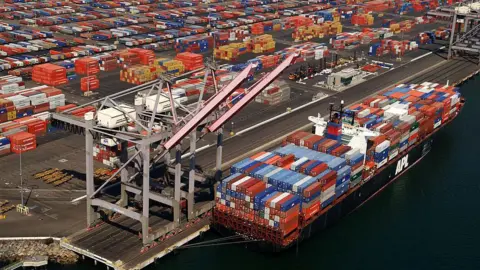The International Monetary Fund (IMF) has recently upgraded its global economic growth forecast, attributing this positive development to the easing of some tariffs imposed on goods by the United States. This new projection indicates a more favorable economic outlook compared to what was previously anticipated back in April. Notably, the recent surge in U.S. imports is attributed to companies proactively importing goods to circumvent impending higher tariffs, while actions taken by various governments to stimulate economic growth have also contributed to this upward revision.
The IMF’s revisions reflect a promising recovery trajectory for the global economy. However, despite the encouraging news, the organization has cautioned that the lingering effects of higher tariffs and economic uncertainty could still hamper growth rates, leading to potential slowdowns in economic activity. Specifically, the IMF highlighted that while the forecast remains optimistic, various factors, including the sustainability of this recovery amid ongoing trade concerns, warrant careful monitoring.
Focusing specifically on the United Kingdom, the IMF forecasted a growth rate of 1.2% for the current year, with a slight uptick to 1.4% expected in 2026. This projection remains unchanged compared to the revised estimates published in May. Surprisingly, the UK is positioned to be one of the top three fastest-growing advanced economies globally this year, alongside the United States and Canada. This information highlights the UK’s resilience amid a challenging economic landscape, positioning it favorably in the international market.
A crucial element contributing to these revisions is the phenomenon of “trade front-loading.” This term describes the rush of imports into the U.S. market as companies sought to bring in goods before new tariffs came into effect, driven by then-President Donald Trump’s trade policies. This surge allowed businesses to stock up on inventory, thus facilitating a temporary boost in U.S. economic activity. As per the latest IMF analysis, the projections for global growth stand at an anticipated 3% for 2025 and 3.1% for 2026, reflecting an increase from the previous forecasts of 2.8% and 3%, respectively.
However, the IMF’s report also posits inherent risks associated with these developments. For instance, with the anticipation of higher tariffs, American businesses have hastily increased their stock levels, which may create potential challenges. Should a future economic shock occur, companies could find themselves overstocked, resulting in diminished demand for new imports.
Additionally, this stockpiling trend poses logistical challenges; firms may incur higher costs for storage, and there is a risk that certain goods could become obsolete. This reality calls for enhanced vigilance and strategic foresight among companies as they navigate the evolving trade landscape. The IMF underscored the need for businesses to remain adaptable and responsive to changes in both market demand and policy environment to mitigate potential negative consequences.
In conclusion, the IMF’s upgraded global growth forecast provides a cautiously optimistic outlook for the world economy. Easing trade tensions, particularly in the context of U.S. tariffs, coupled with proactive economic measures from governments, suggest a path toward recovery. However, the IMF’s warning about the risks of heightened inventory levels and trade uncertainties serves as a critical reminder that vigilance and adaptability remain essential in this evolving economic landscape. As stakeholders assess these developments, the interplay of trade dynamics will undoubtedly continue to shape global economic fortunes in the years ahead.












